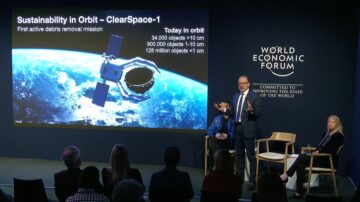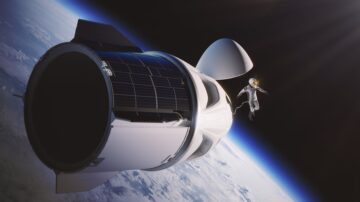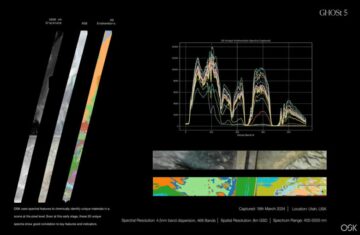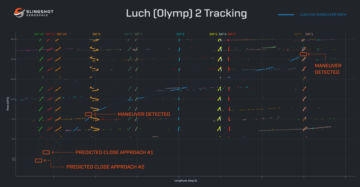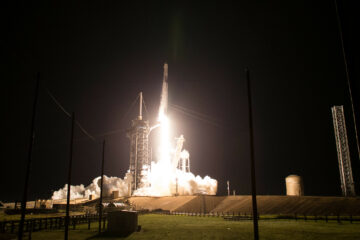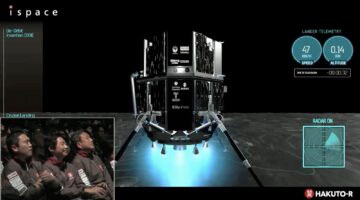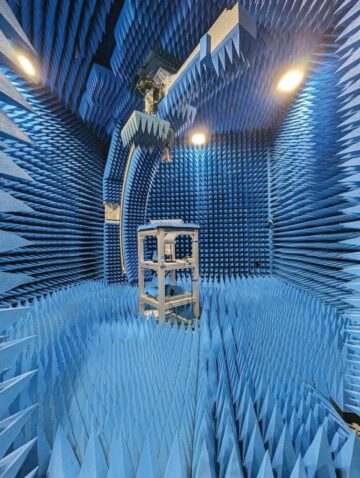
SAN FRANCISCO — Copernic Space is selling digital capacity and lunar assets for a 2024 moon mission.
It’s the latest step in the Los Angeles startup’s campaign to create a digital marketplace for selling and financing space assets.
Copernic Space lunar payload will be housed in a capsule from San Francisco startup LifeShip. LifeShip is collecting DNA from customers as part of its campaign to establish a lunar seed bank and data archive. The LifeShip capsule is scheduled to launch in 2024 on a SpaceX Falcon 9 rocket. If all goes as planned, it will touch down in the northern lunar hemisphere’s Mare Crisium in Firefly Aerospace’s Blue Ghost 1 lunar lander.
In the past Copernic Space sold payload space for customers including Lunar Outpost. Recently, Copernic Space opted to invest in its own lunar payload because “that way we can control the business process,” said Grant Blaisdell, Copernic Space co-founder and CEO. “I can break down the accessibility barriers and the economic barriers. By taking a big asset and fractionalizing it, I can enable a whole different commercial and even consumer segment to access the space market.”
Digital assets being sent in the Copernic Space lunar payload include music, code, fine art collections, company registrations and videos.
In addition, Axiom Space3, the Web3 technologies arm of the space infrastructure developer, is holding a contest to select the first meme to send to the moon as a tokenized asset. Another Copernic Space customer is Sophiaverse, a joint venture established in 2016 by Hanson Robotics and SingularityNet Foundation.
Perun Rocket
Last fall, Copernic Space sold 24 payload slots on the October test flight of the Perun rocket from Poland’s SpaceForest.
“We sold it out in about a day and a half,” Blaisdell said.
Perun payload customers included crypto startups, artists, a music festival and a Ukrainian philanthropic organization that sponsored the flight of a Space Barbie doll.
“We tokenized them as real-world space assets,” Blaisdell said. “So, they have verified ownership of their assets that they sent into space.”
Real-world assets are blockchain-based digital tokens that represent physical assets like a doll or a satellite as well as digital assets like artwork or satellite imagery licenses. Copernic Space spent the last two years working with payload providers to create a standard for tokenizing payload slots, payloads and real-world space assets.
The single-stage Perun rocket, launched from a Polish Air Force Training Center, reached an altitude of approximately 10 kilometers before its engine failed. SpaceForest recovered the rocket after it splashed down in the Baltic Sea. Through the flight, SpaceForest demonstrated test control algorithms, recovery and launch procedures.
For Copernic Space, the flight proved “that you can generate revenue” by selling payload slots through this new model, Blaisdell said. “We’ve built an entire space business with a reseller network of paying users on our platform to help develop and scale the commercial buying market for space assets.”
- SEO Powered Content & PR Distribution. Get Amplified Today.
- PlatoData.Network Vertical Generative Ai. Empower Yourself. Access Here.
- PlatoAiStream. Web3 Intelligence. Knowledge Amplified. Access Here.
- PlatoESG. Carbon, CleanTech, Energy, Environment, Solar, Waste Management. Access Here.
- PlatoHealth. Biotech and Clinical Trials Intelligence. Access Here.
- Source: https://spacenews.com/copernic-space-sells-digital-assets-for-2024-lunar-flight/
- :is
- 1
- 10
- 2016
- 2024
- 24
- 9
- a
- About
- access
- accessibility
- addition
- After
- AIR
- Air Force
- All
- an
- and
- Angeles
- Another
- approximately
- Archive
- ARE
- ARM
- Art
- Artists
- artwork
- AS
- asset
- Assets
- Bank
- barriers
- BE
- because
- before
- being
- Big
- blockchain-based
- Blue
- Break
- built
- business
- Business Process
- Buying
- by
- Campaign
- CAN
- Capacity
- Center
- ceo
- Co-founder
- code
- collections
- commercial
- company
- consumer
- control
- create
- crypto
- crypto startups
- customer
- Customers
- data
- day
- demonstrated
- develop
- Developer
- different
- digital
- Digital Assets
- digital marketplace
- digital tokens
- down
- Economic
- enable
- Engine
- Entire
- establish
- established
- Even
- Failed
- falcon
- Falcon 9
- Fall
- FESTIVAL
- financing
- fine
- Fine Art
- First
- flight
- For
- Force
- Foundation
- Francisco
- from
- generate
- Ghost
- Goes
- grant
- Half
- Have
- help
- HTTPS
- i
- if
- in
- include
- included
- Including
- Infrastructure
- into
- Invest
- IT
- ITS
- joint
- joint venture
- kilometers
- Last
- latest
- launch
- launched
- licenses
- like
- los
- Los Angeles
- Lunar
- lunar lander
- Market
- marketplace
- meme
- Mission
- model
- Moon
- Music
- network
- New
- october
- of
- on
- or
- organization
- our
- out
- own
- ownership
- part
- past
- paying
- philanthropic
- physical
- planned
- platform
- plato
- Plato Data Intelligence
- PlatoData
- Polish
- procedures
- process
- proved
- providers
- reached
- real world
- recently
- recovery
- represent
- robotics
- rocket
- Said
- San
- San Francisco
- satellite
- satellite imagery
- Scale
- scheduled
- SEA
- seed
- segment
- select
- Selling
- Sells
- send
- sent
- slots
- sold
- Space
- SpaceX
- spent
- Sponsored
- standard
- startup
- Startups
- Step
- taking
- Technologies
- test
- that
- The
- their
- Them
- they
- this
- Through
- to
- tokenized
- tokenizing
- Tokens
- touch
- Training
- two
- Ukrainian
- users
- venture
- verified
- Videos
- Way..
- we
- Web3
- web3 technologies
- WELL
- whole
- will
- with
- working
- years
- you
- zephyrnet

